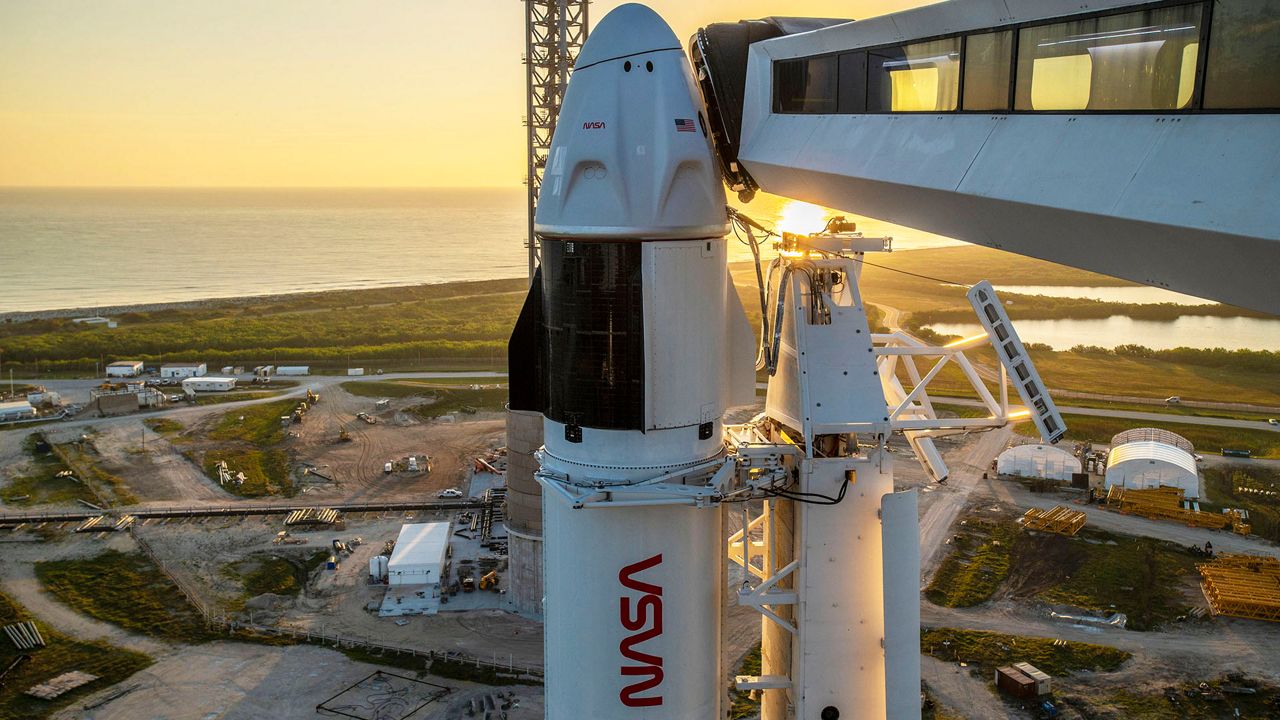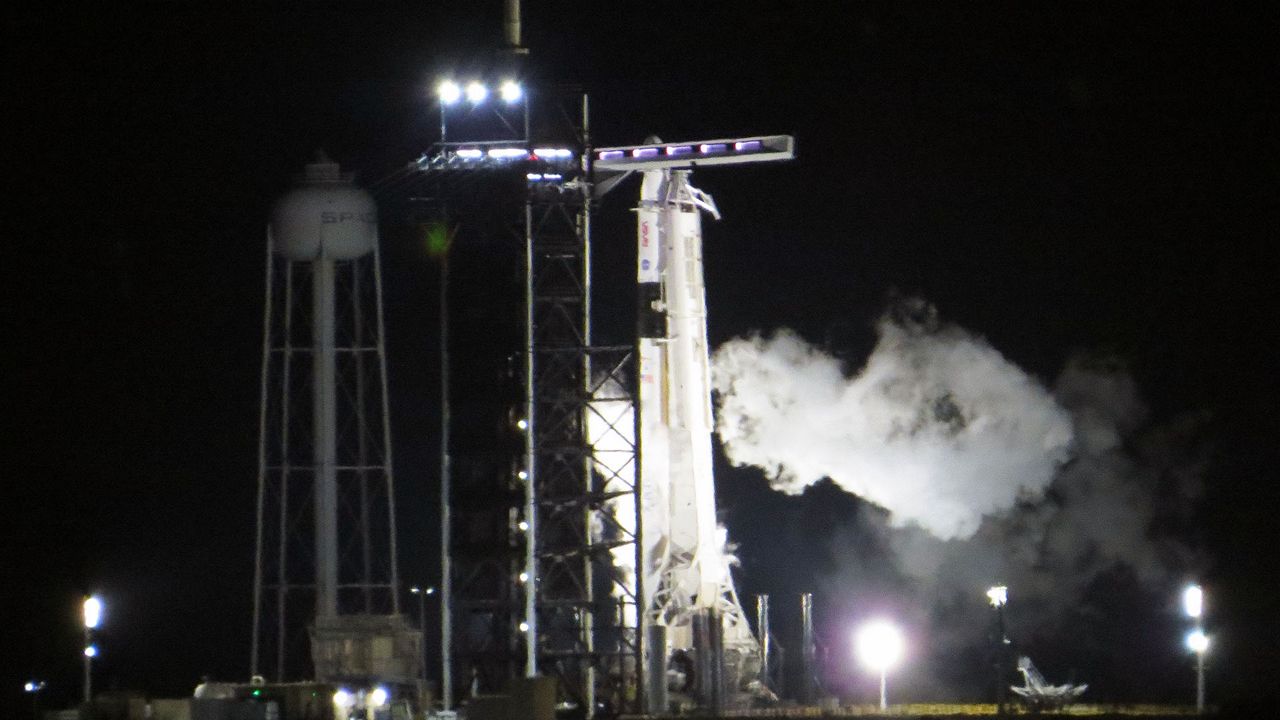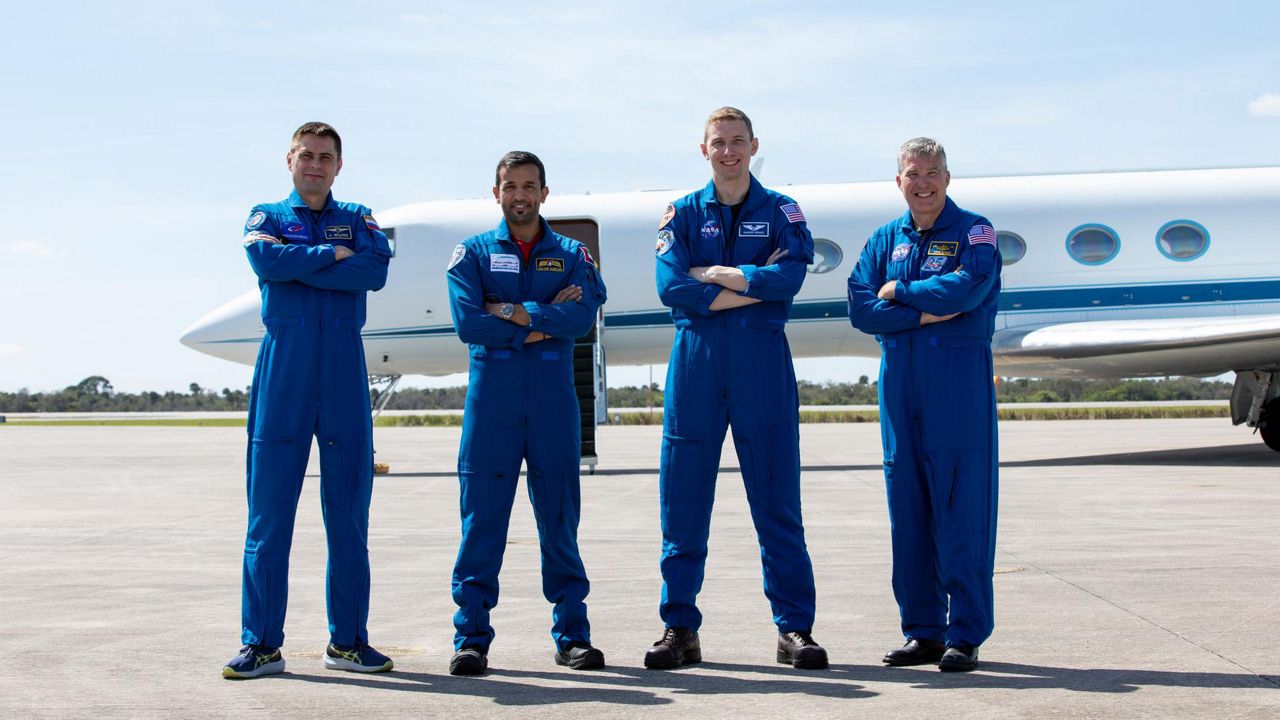KENNEDY SPACE CENTER — Despite the delays, countless space fans cheered on as NASA and SpaceX sent their joint Crew-6 mission to the International Space Station during the very early morning hours on Thursday.
What You Need To Know
- NASA personnel say a clogged filter was the reason Monday's first Crew-6 launch attempt was scrubbed
- Officials say the majority of Crew-6's personnel have never been to space
- BELOW: Learn about the mission and a few of the more than 200 experiments, and meet the members of Crew-6
- RELATED: Meet the four-member group of the SpaceX Crew-6 mission
- 🔻Scroll down to watch the launch🔻
Countdown to the Crew-6 launch
The second launch attempt
SpaceX’s Falcon 9 rocket sent NASA astronauts Mission Commander Stephen Bowen and pilot Warren Hoburg and mission specialists United Arab Emirates astronaut Sultan Alneyadi and Roscosmos cosmonaut Andrey Fedyaev to the ISS, despite a clogged filter that prevented the first attempt earlier in the week.
The rocket launched SpaceX’s Crew Dragon capsule the Endeavour (and the human crew) from Launch Complex 39A at NASA’s Kennedy Space Center during the instantaneous launch window at 12:34 a.m. EST, confirmed SpaceX and NASA.
🚀 #LIFTOFF! The #Falcon9 rocket takes off, carrying the @NASA-@SpaceX #Crew6 to the #ISS. @MyNews13 has more. https://t.co/rksje13NcL pic.twitter.com/ZfgMd4aHrZ
— Anthony Leone (@AnthonyLeone) March 2, 2023
While there were delays, it is almost kismet that the Crew-6 launch happened on March 2 because it was on that date back in 2019 when the uncrewed SpaceX Demo-1 was launched. It was the first orbital test of the Dragon spacecraft.
This is not the first time the launch was pushed back. Originally, it was scheduled for 2:07 a.m. EST, Sunday, Feb. 26, but NASA announced the new date and time during a media teleconference on Tuesday, Feb. 21.
“When we looked at the work remaining to go, primarily on the vehicle, getting the Dragon and Falcon 9 ready to go, we were a little bit behind on that work and so we needed a little bit more time to do that,” NASA’s Commercial Crew Program Deputy Manger Steve Stich explained during the teleconference.
That new date and time were 1:45 a.m. EST, Monday, Feb. 27, but there was an issue regarding a clogged filter. (See below) Both NASA and SpaceX had been considering scheduling the next launch opportunity for Tuesday, Feb. 28, but decided against it due to poor weather conditions.
But despite it all, the March 2 launch was a success, with even the weather participating.
The Cape Canaveral Space Force Station’s 45th Weather Squadron gave a 95% chance of good launch weather for Thursday morning, with the only concern being a flight through precipitation rule.
On Wednesday night, as many waited to see the launch, First Lt. Adam Thaler of the 45th Weather Squadron explained to Spectrum News what type of weather conditions experts were keeping an eye on.
He said that while "the weather is looking really good," he said that officials were looking at the ascent corridor, which was causing some concern.
First Lt. Adam Thaler of the 45th Weather Squadron explains to me what type of weather conditions officials are looking out for as many wait to see the @NASA-@SpaceX #Crew6 launch.
— Anthony Leone (@AnthonyLeone) March 2, 2023
Go to @MyNews13 for more about the mission. https://t.co/rksje13NcL pic.twitter.com/6yP9KwbFEk
Since the launch happened, in a little more than 24 hours, Endeavour will dock with the ISS’ Harmony module at 1:17 a.m., Friday, March 3, stated NASA.
The first attempt and a clogged filter
On Monday, the countdown was put on hold moments from the 1:45 a.m. EST launch, at 2 minutes, 18 seconds, because ground crews noticed unusual data signatures with the triethylaluminum triethylboron (TEA-TEB) chemicals, which are used to ignite the liquid oxygen and kerosene fuel in the Falcon 9 rocket’s nine first-stage Merlin engines.
Standing down from tonight's launch of Crew-6 due to a TEA-TEB ground system issue. Both Crew-6 and the vehicles are healthy and propellant offload has begun ahead of the crew disembarking Dragon
— SpaceX (@SpaceX) February 27, 2023
On Wednesday, NASA officials said the cause of the issue was a clogged ground filter.
“After a thorough review of the data and ground system, NASA and SpaceX determined there was a reduced flow back to the ground TEA-TEB catch tank due to a clogged ground filter. This clogged filter fully-explained the signature observed on the launch attempt. SpaceX teams replaced the filter, purged the TEA-TEB line with nitrogen, and verified the lines are clean and ready for launch,” NASA stated.
Instead of going to the ISS on Monday morning, the four-person crew had to wait in their seats as the Falcon 9 rocket was being de-fueled.
Despite the setback, NASA Administrator Bill Nelson tweeted early Monday morning that he was proud of how both NASA and SpaceX take safety seriously.
I’m proud of the @NASA and @SpaceX teams’ focus and dedication to keeping #Crew6 safe.
— Bill Nelson (@SenBillNelson) February 27, 2023
Human spaceflight is an inherently risky endeavor and, as always, we will fly when we are ready. https://t.co/EBfzzHdH5l pic.twitter.com/ljKWpG9sPU

Getting to know the vehicle
Once the launch does happen, the speeds that will be on both the vehicle and the crew during liftoff will be something else.
“Lifting off from Launch Pad 39A on a Falcon 9 rocket, Dragon Endeavour will accelerate its four passengers to approximately 17,500 mph, putting it on an intercept course with the space station,” NASA officials explained.
To reach those speeds, the nearly 230-foot Falcon 9 rocket has nine SpaceX Merlin engines, which can lift a payload of 50,265 pounds and send it to low-Earth orbit — the same neighborhood where the ISS is staying, in a manner of speaking.
As far as the 26.7-foot tall Dragon capsule, the Endeavour has been around the block a few times. The capsule, which can hold up to seven people, has successfully carried the following missions:
This is the first mission for first-stage booster B1078. Once stage separation happened, it landed on the droneship Just Read the Instructions, which was stationed in the Atlantic Ocean.
Falcon 9’s first stage booster has landed on the Just Read the Instructions droneship pic.twitter.com/aTsxNo2cJN
— SpaceX (@SpaceX) March 2, 2023

About the mission
Once the Endeavour docks on the ISS’ Harmony module — which acts as a connecting port between a spacecraft and the station itself — Crew-6 will become members of the latest ISS crew, which will then be called Expedition 69.
ISS expeditions are missions that can last about six months.
And Crew-5 and Crew-6 will get to spend a little time together.
“The astronauts of NASA's SpaceX Crew-5 mission will undock from the space station and splash down off the coast of Florida several days after Crew-6's arrival,” NASA stated.
During the teleconference, International Space Station Program Deputy Manager Dana Weigel said that the Crew-6 will be on the floating laboratory for half a year, and will be quite busy.
“We’re excited to welcome Crew-6 on board," Weigel said. "They’ll be there for about six months. They’ll have a really busy increment supporting numerous vehicles that will come and go and they’ll have more than 200 science experiments and technology demonstrations that they’ll be supporting."
According to the space agency, some of those experiments include studying how certain materials burn in microgravity; tissue clip research on the heart, brain and cartilage functions; and collecting microbial samples from outside of the ISS.
And yes, microbial as in living organisms, but not the alien kind.
“No matter how well crewed spaceships or spacesuits are cleaned, the humans inside continually regenerate microbial contaminants,” explained the experiment’s overview.
And Crew-6 will be doing much more to further space exploration, officials say.
“They’ve got a wide range of research objectives, including investigations aimed at furthering capabilities that we will need for going beyond low-Earth orbits," Weigel said. "So those are things that we’re looking at for either going to the moon or beyond to Mars."
Late Sunday night, Patrick O'Neill, the public affairs manager for the International Space Station U.S. National Laboratory, expanded on the importance of the experiments being conducted on the ISS.
Patrick O'Neill of the @ISS_CASIS spoke to me about the importance of sending experiments to the @Space_Station and what that means here on Earth.
— Anthony Leone (@AnthonyLeone) February 27, 2023
Follow @MyNews13 for more #Crew6 coverage. https://t.co/rksje13NcL pic.twitter.com/pydToDrO0m

Meet Crew-6
Learn more about the men of the Crew-6 right here.
Mission Commander Stephen Bowen: A retired U.S. Navy captain, he is no stranger to space. He has logged more than 47 days in space during the space shuttle days.
Pilot Warren Hoburg: Before being selected by NASA to join the agency’s 2017 Astronaut Candidate Class he earned a bachelor’s degree in aeronautics and astronautics from MIT and a doctorate in electrical engineering and computer science from the University of California. This will be his first time in space.
United Arab Emirates astronaut Sultan Alneyadi: Before he became certified to work as an operator aboard the ISS, he has a bachelor’s degree in science in electronics and communications engineering from the UK’s University of Brighton, received his Master's degree in IT at Griffith University in Australia and earned a Ph.D. in information technology. This will be his first time in space.
Roscosmos cosmonaut Andrey Fedyaev: He was a military pilot in Russia with more than 600 hours of flight time. He earned a degree in operation of air transport and air traffic control/pilot engineer from Krasnodar Military Aviation Institute. This will be his first time being in space.



